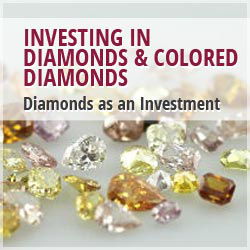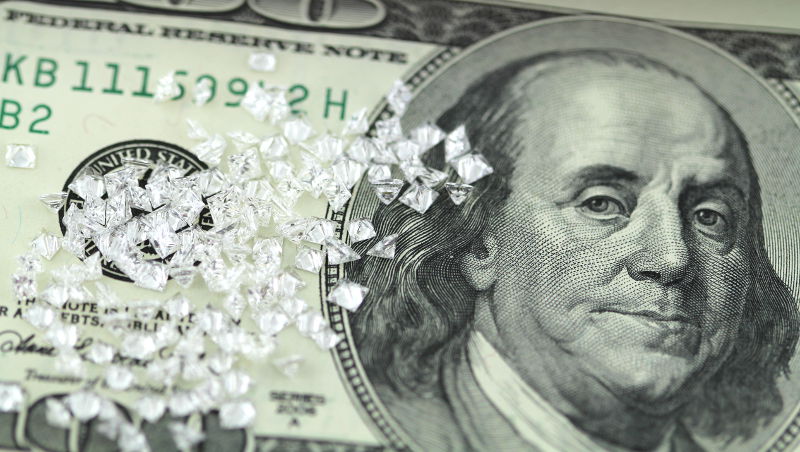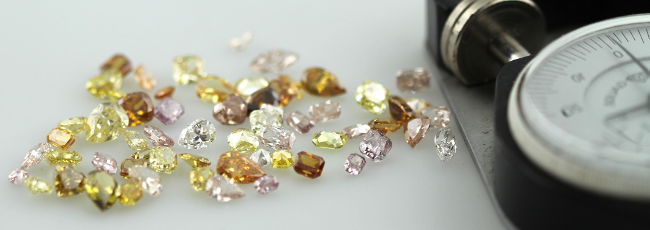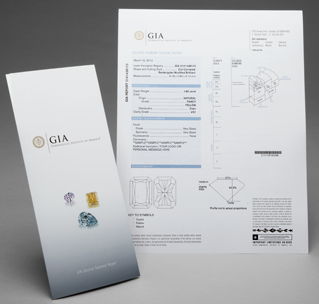Investing in Diamonds?
All about Diamond Investment
- Home /
- Diamond Buying Guides /
- Diamond Investment

Since 2008 the global economy has known many ups and downs - but mainly downs.
It is during these difficult times that people start to watch out for their money and look for real alternatives.
It is also during these times that we learn and appreciate the advantages of physical commodities.
This is why we see the increase in the value of gold, silver and lately... diamonds and natural colored diamonds.
Diamonds as an Investment
The use of diamonds as an investment and financial hedging tool has grown rapidly over the last few years to point that there is even an interesting section about it in Wikipedia.
The reason is quite obvious and actually makes lots of sense:
-
Diamonds don't take up room -
Diamonds have forever been used as an excellent means of transfer. The fact that such a small item can be worth so much money is astounding. You can easily keep a one million dollar diamond in the smallest of safes. -
A diamond is durable - It doesn’t break or wear off -
As the hardest substance on earth you do not have to worry about anything happening to it. All you have to do is to make sure you do not lose it! (and even that can be insured). -
Inflation Proof -
This is actually true to most physical commodities. Real estate, gold, silver and diamonds usually appreciate in compliance to inflation. Unlike the others, diamonds are more durable and movable. This is also why even if you do not want to buy diamonds for investment buy just considering an alternative form for putting some money aside diamonds make a good choice. -
You can enjoy it while you have it -
Since diamonds do not wear off and technically there is no meaning to selling a "second hand" diamond, you can mount it and wear it while you use it for investment purposes. -
Psychology -
It is physical. You can hold it, look at it and even wear it. It makes you feel safer unlike stocks and other financial items which are rows on a computer screen.
Besides the psychology and physical aspects there are also financial advantages to buying diamonds for investment purposes which we'll show below. But first thing first -

How to Invest in Diamonds?
Diamond investment should fall into your category of alternative investments with all it entails.
This means that they should be a small portion of your portfolio etc.
The idea is actually quite simple. As I mentioned, investing in diamonds is based on the fact that diamonds are physical commodities. As such, you can easily buy them everywhere, even online. The recommendations below are the basic guidelines, a how to invest in diamonds tips and tricks if you wish. But most important we also cover the risks so please read thoroughly till the end…
-
Learn the basics (at least)
You should start at the beginning. Learn the basics, the diamond language. Start with the 4 Cs of Diamonds. If you had your mind set on investing in colored diamonds then I highly recommend continuing right after this article to our How to Choose a Colored Diamond guide. -
Set a budget
Keep in mind that this should be a part of your portfolio. True, unlike stocks, the initial amount that is required is a bit higher but this is no reason to go over the budget or over the ration of your portfolio that you had in mind. -
Diversify your diamonds
Don't put all the eggs in one basket. Even though it was Warren Buffett who said "Diversification is protection against ignorance, it makes little sense for those who know what they’re doing", we can't all be Buffett. In diamond investment like in other investments it may be wise to diversify your "portfolio". If you had set your diamond investment budget on $20,000 then you should consider buying 2 x $10,000 diamonds or even split it into three. On top of that, don't buy two / three diamonds of the same type. If you had your heart set up on a pink diamond then it might be smart that the second diamond will be blue, green or even yellow. You don't know which will rise more or alternatively which will be easier to sell later on. Also, this is great since it will enable you to liquidate a portion of your portfolio in case you need to allocate some of your investment funds. Mixed Parcel of Natural Colored Diamonds
Mixed Parcel of Natural Colored Diamonds
-
Compare Prices
Forgive me for repeating the obvious comparison to stocks but a diamond is not a stock. A diamond's price is not set by thousands of buyers and sellers bidding online in a transparent platform. However, with the huge amount of online retailers you can easily compare asking prices for similar diamonds (this is harder to do when it comes to colored diamonds where each diamond is different). -
Buy rare yet desired - use logic
I personally don't see too much point in buying something that everyone has. I've seen mentions about buying a round 1 carat D VS diamonds for investment but when time comes to liquidate your investment, you are selling something that can easily be bought elsewhere - you are competing with many other sellers (and manufacturers).
However, if you have a special natural colored diamond, for example a blue diamond or a pink diamond, you are on a league of your own. However, keep thinking of "desired". For example, it will be easier to sell a cushion cut or a round diamond (even if pink) than a marquise. It will be easier to sell a VS blue diamond than one with I2 clarity (even though it is reflected in pricing). Use common sense and trust your instincts about what to stay away from.
To get inspired, look at the most expensive diamond (and the trailing 10 for that matter). -
Know what you are getting
 Buy only certified diamonds. Do not trust what the seller is saying (or writing in case it is online). Keep in mind that every minor change in a diamond's attributes means a lot of money. We highly recommend buying diamonds specifically with GIA certificates. This is probably the most known gemological laboratory and also a very strict one.
Buy only certified diamonds. Do not trust what the seller is saying (or writing in case it is online). Keep in mind that every minor change in a diamond's attributes means a lot of money. We highly recommend buying diamonds specifically with GIA certificates. This is probably the most known gemological laboratory and also a very strict one.
Besides for the buying part of the investment, consider that when it is time to sell your diamonds your buyer will probably also want to see a GIA grading report. When it comes to colorless diamonds the IGI is also considered quite strict but when it comes to colored diamonds the GIA are to this day the only ones to trust. -
Mounted or Loose
Most chances are that when the time comes and you wish to liquidate your investment (sell your diamond) the person who buys it has its own agenda for it. Maybe like you he buys it for investment but most probably it will be for a setting that he dreamt of. This is why you would probably get zero value for your setting and only the diamond itself will be calculated for assessing the value.
But does it mean that you shouldn't mount it? Not necessarily. Not everyone can imagine how a diamond looks when mounted. A good and smart setting can very much be a great tool that will help you sell the diamond. Good settings can emphasis the color and hide inclusions. In fact, most of the extremely rare diamonds that you hear about selling in auctions by Christie's and Sotheby's are mounted. And let's not forget that when mounted you can enjoy it while you have it.
Small note, it is practically impossible to grade diamonds while mounted. True, if you followed our instructions you had bought a diamond with a GIA certificate that states its attributes - but still, an experienced buyer might very well ask you to remove it from its setting. In this case I recommend you to do it as a contingency to him purchasing the diamond if all is ok. -
Buy Your Diamonds Cheap
This Paragraph is in continuation to the above section. Buying at a retailer means that you bought your diamond after many brokers and mediators got their share. By buying cheap we do not mean to buy cheap diamonds (on the contrary). This means buying as high up the chain of distribution as you can. Skip the mediators. Try buying directly from manufacturers. Many diamond manufacturers (like us) now have online stores and are happily willing to sell directly to the end customers. Just make sure to stick to our buying diamonds online safety tips. -
Don't be shy
Ask many questions. Try to reach diamond experts and consultants. Use diamond forums. It is the age of sharing and carrying. Social networks are full of people that would be more than happy to assist. Some probably already invested in diamonds and can share their personal experience.
What are the Advantages to Investing in Colored Diamonds?
When looking to make an investment, any investment, you need to consider several things including how you exit. Some investors will go ahead and say that it is the most important part of the investment. The first advantage of colored diamonds is exactly that…
As mentioned above it is in my personal opinion that trying to sell a 1 carat D VS1 diamond will be quite difficult. Don't get me wrong, a 1 carat D VS will probably be easier selling than a 1 carat D Flawless because a D FL costs so much more while providing the end customer so little added value that the amount of people that are willing to pay this premium is very limited. For those who don't know, in VS1 diamonds you cannot see the inclusions without a loupe and for the non-professionals probably even with a loupe.
It is a delicate equation. You need to find the right diamond that has enough demand and on the other side of the equation there are only few sellers - investment grade diamonds. Colored diamonds by definition fall exactly into that category. The supply is limited being that only 1 out of 10,000 diamonds is a natural colored diamond and the demand is constantly rising. They are unique and sought after. It seems that the equation keeps tilting the right way and as a diamond investor - time is on your side.
 Natural Yellow Diamonds - standing out in the crowd
Natural Yellow Diamonds - standing out in the crowd
This also takes us directly into the second advantage which is (to our opinion) that there are more reasons for colored diamonds prices to increase than in regular colorless diamonds.
Consider yourself - Did you know about colored diamonds 20 years ago?
There is an expectance for a strong increase in demand for diamonds (all diamonds) from the evolving markets such as China and India where the middle class is growing every year. Regardless, there is also a strong increase in demand for natural colored diamonds in matured and evolved markets that are now getting more familiar with it. Colored diamonds are by far rarer. When we connect the dots, investing in colored diamonds makes sense.
What are The Disadvantages and Risks to Investing in Diamonds?
There are three major risks and disadvantages when it comes to diamond investment -
-
Price Transparency -
While other merchandises such as gold and silver have a price index that can be followed and checked in the stock exchange - diamonds do not! There is the Rapaport price list which most diamond dealers rely on but this is not enough on its own. The list is used as a benchmark and even if you can get a copy, it won't be useful for several reasons. It takes into account only the basic factors of carat weight, clarity and color. At the end, the price is determined by the market - supply and demand. Merchants buy certain diamonds above the price list and also below it. A 10% difference means a lot. Also, this list refers only to white colorless diamonds and there is no current list (or benchmark) to colored diamonds.
The way to overcome this downside is doing a lot of research. Buy from a reputable merchant of is known to be fair and make sure to compare prices online. -
Lack of Tradability -
Buying a diamond is relatively easy. However, selling one is a completely different story. There are some companies who buy diamonds just as there are some who buy gold but these will pay on the lower side of prices. You can always try and sell it on Craig's list and similar. Or, you can try selling it to other retailers but they will probably be tough negotiators and you'll have to beat their supplier either in pricing or in the rarity of your gem. The last option which is reserved to the high-end pieces is trying to sell your diamond through the auction houses. Diamond auctions arranged by Christie's and Sotheby's are luring lots of diamond investors and collectors. The problem with those is that they mostly accept the unique gems and that their fee is considered expensive by some. -
Patience is a Virtue -
Diamonds are not stocks. There is little to no chance that the value of the diamond you bought will spike 30% the next year (not that it happens too often in stocks as well). Consider the diamonds you bought in the part of portfolio that is intended for long term investment. Remember, good things come to those who wait!
An Alternative Diamond Investment
So, you decided that the diamond industry is fascinating (or at least has the potential to make money from it). However, you do not have enough funds or knowledge to make an investment in it just yet. There is an alternative solution…
Along this article we compared investing in diamonds to investing in stocks - and pointed out the differences between the two. However, you can also invest in diamonds (alternatively) by buying stocks of diamond related companies.
Diamond Education
Unfortunately, at the time of writing these lines, there is only one ETF (Exchange Traded Fund) that tracks diamonds and gemstones companies. GEMS by FactorShares is investing in a variety of firms that produce and sell diamonds. More ETFs like this are expected to rise within the next couple of years.

Another way is to create a portfolio on your own.
For example, approximately 70% of the diamond mining industry is held by four major companies – De Beers (which is mainly owned by British Anglo American), Alrosa (held mainly by the Russian government), Rio Tinto and BHP Billiton.
While Rio and BHP are mining giants, diamond mining takes only a small portion of their businesses (and constantly talks about selling it) and they are accountant for roughly 15% of the total mining industry.
You can also invest in the diamond jewelry companies such as Tiffany and Harry Winston which is a combination of a mining company and a retailer.
However, there is no alternative ETF or company stock that specializes in natural colored diamonds.
Are Diamonds a Good Investment?
Any investment involves a portion of speculation. All you can do is try to make a smart one based on all of the information you can obtain.
If we try to conclude all that was written above, not surprisingly, diamonds as an investment have their pros and of course their cons. I strongly believe that their upside and potential easily overcomes their cons. Just be aware of the downsides and use it wisely to minimize the risks involved.
As Anja Winikka, site director of TheKnot.com recently told CNBC, approximately 93% of couples get married with a diamond engagement ring!
Think it will change anytime soon?
